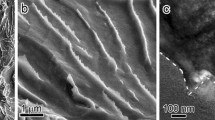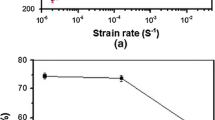Abstract
Hydrogen embrittlement of metals has been investigated by many researchers. However, the contradictions between experimental data and the existing concepts on the mechanism of hydrogen embrittlement explain the need for new experiments establishing additional factors affecting the time and temperature dependence of the ductility of hydrogen-charged metals. An analysis of the published data and results of experiments on hydrogen embrittlement are presented in the present paper.
Similar content being viewed by others
References
K. V. Popov.Dynamic Deformation Aging and Hydrogen-Type Brittleness [in Russian], Nauka, Novosibirsk (1969).
V. P. Krylov and Z. L. Zlatin, “Deformability of commercial iron,”Metalloved. Term, Obrab, Met., No. 12, 41 - 43 (1976).
M. Taheri, S. Albrecht, I. M. Bernstein, and A. W. Thompson,Ser. Metall.,13(9). 871 - 875 (1979).
G. G. Nelson, “Hydrogen embrittlement,” in:Embrittlement of Structural Metals and Alloys [Russian translation], K. L. Brayont and S. K. Banerdji (eds.), Metallugiya, Moscow (1988).
A. V. Bobylev.Mechanical and Technological Properties of Metals [in Russian], Metallurgiya, Moscow (1979).
M. I. Kochnev, “On correspondence between the temperatures of anomalous changes in the properties of copper, its compounds and alloys.”Izv. Akad Nauk SSSR, Otd. Tekh. Nauk, No. 12, 96 - 105 (1956).
A. A. Presnyakov and V. V. Chervyakova,Nature of Ductility Minima in Metallic Alloys [in Russian], Nauka, Alma-Ata (1970)
P. Kotterill.HydrogenEmbrittlement of Metals [Russian translation]. Metallurgizdat, Moscow (1963).
B. A. Kolachev, V. A. Livanov, and A. A. Bukhanova,Mechanical Properties of Titanium and Its Alloys [in Russian], Metallurgiya, Moscow (1974).
G. Hörtz,Metall., No. 8, 731 - 737 (1976).
V. P. Krylov and V. I. Panov, “Temperature dependence of the ductility of hydrogen-charged commercial titanium and alloys VT3-1 and VT 15,”Metalloved. Term. Obrab. Met., No. 7 48 - 50 (1990).
B. A. Kolachev,Hydrogen Embrittlement of Metals [in Russian], Metallurgizdat, Moscow (1985).
M. A. Krishtall, Yu. V. Piguzov, and S. A. Golovin,Internal Friction in Metals and Alloys [in Russian], Metallurgiya, Moscow (1964).
N. A. Galaktionova,Hydrogen in Metals [in Russian], Metallurgiya, Moscow (1967).
K. D. McMagon, “Microductility of iron” in:Microductility [Russian translation], Metallurgiya, Moscow (1972).
J. L. Benson and P. Boch, “Inelastic effects in cold-worked nickel,”Acta Metallurgica, 26(8), 1243 - 1250 (1978).
A. K. Litvin and V. I. Tkachev, “Phenomenon of easier deformation and disruption of metal in the presence of hydrogen,”Fiz. Khim. Mekh. Met., 12(12), 27 - 34 (1976).
R. R. Hasiguti, N. Igata, and G. Kamashita,Acta Metallurgica,10(4), 442 (1962).
A. L. Eustice and O. N. Carlson,Trans. AIME,221(2), 238 (1961).
Mozazumi Shotaro and Mashida Jutaka,J. Jap. Inst. Metals,41(2), 1256 - 1264 (1978).
V. A. Finkel',Low-Temperature X-Ray Diffractometry [in Russian], Metallurgiya, Moscow (1971).
V. M. Azhazha, N. V. Vol'kenshtein, and V. E. Startsev, “Electrical conductivity of high-purity vanadium. Investigation ofT k. and anomalies in the temperature dependence,Fiz. Mekh. Met.,41(6), 1188 - 1195 (1976).
L. S. Moroz and B. B. Chechulin,Hydrogen Embrittlement of Metals [in Russian], Metallurgiya, Moscow (1967).
L. Mignolet,J. Chem. Phys.,23(4). 23 (1955).
B. F. Mattias,Helv. Phys. Acta,46. 6 - 7, 1030 (1968).
R. Cahn,Physical Metallurgy, Issue I (Atomic Structure of Metals and Alloys), Amsterdam (1965).
A. K. Mindyuk, “Role of temperature in the formation of physicomechanical properties of metals,”Fiz. Khim, Mekh. Met.,23(2), 97 - 102 (1987).
A. I. Mezentsev and A. F. Mikhailov, “To the problem of call brittleness of metals,”Metalloved. Term. Obrab. Met., No. 5, 46 - 49 (1973).
Author information
Authors and Affiliations
Rights and permissions
About this article
Cite this article
Krylov, V.P. Anomalies in the deformability of degassed metals at temperatures of reversible hydrogen embrittlement. Met Sci Heat Treat 37, 495–498 (1995). https://doi.org/10.1007/BF01157072
Issue Date:
DOI: https://doi.org/10.1007/BF01157072




